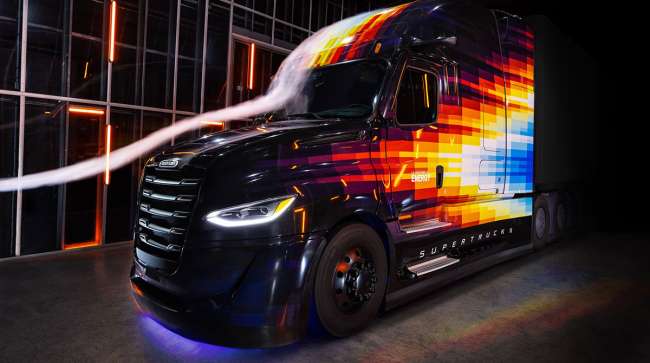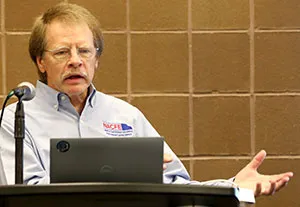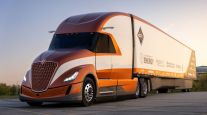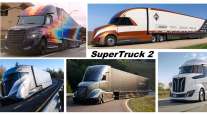Staff Reporter
SuperTruck Project Propels Real-World Gains, OEMs Say

[Stay on top of transportation news: Get TTNews in your inbox.]
NEW ORLEANS — Participants in the U.S. Department of Energy’s SuperTruck program detailed how the initiative has propelled development of technologies that advance efficiency improvements for everyday trucks during a session at the annual meeting of American Trucking Associations’ Technology & Maintenance Council.
“What is interesting about this program is it allows the engineering groups at these different manufacturers to actually look at an entire tractor-trailer as a complete vehicle system and then optimize every piece of that to get the most performance out of the vehicle,” said Rick Mihelic, director of emerging technologies at the North American Council for Freight Efficiency, during the March 5 session. “I’ve worked in the industry 43 years; it is very rare that you get the opportunity to touch the entire vehicle.”
SuperTruck is a public-private collaboration aimed at demonstrating technologies that can improve freight energy efficiency to reduce vehicle operating costs and improve environmental sustainability. It allows participating manufacturers to evaluate their progress against their own baseline with the goal demonstrating improvements in fuel economy and freight efficiency. They also aim to show technologies that have a path to commercialization. Major manufacturers of Class 8 trucks have participated in the program’s first two rounds, and are currently participating in a third focused on development of electric technology.
“These are technologies that have the potential of being viable in the near-term,” Mihelic said. “The ideas are universally applicable in a lot of cases.”

Rick Mihelic says SuperTruck "ideas are universally applicable in a lot of cases.” (John Sommers II for Transport Topics)
NACFE released a report days earlier that determined efficiency innovations developed through SuperTruck have cleared a path to make broader production of zero-emission vehicles more likely. NACFE concluded that advancements made during the program can be used on alternative fuel trucks to increase both range and freight capacity, since much of the progress was focused around aerodynamics, weight and reducing friction.
“SuperTruck 1, we really started with a clean sheet of paper and looked at everything,” said Darek Villeneuve, manager of advanced vehicle systems at Daimler Truck North America. “We uncovered every stone possible to look at efficiency and how that could potentially improve the product. SuperTruck 2, we did a little bit different approach. Of course, we talked a lot with our customers about how they want to use the truck. What was so important for us on SuperTruck 2 was [to] develop technologies that are the most applicable to getting them into production as soon as possible.”

Villeneuve
For SuperTruck 2, Daimler focused on improving the freight efficiency of the truck by examining tractor aerodynamics, powertrain efficiency and rolling resistance. It was able to achieve a 12% improvement in tractor aerodynamics, a 5.7% fuel consumption improvement and reduced rolling resistance by 12% through a combination of developments.
“The intent of both programs has been to identify a path to commercialization for advanced technologies, and we’ve seen success in this from SuperTruck 1, with many of the technologies developed under the program now being standard equipment on today’s production vehicles,” said Ryan Monahan, advanced technology program manager at Paccar, the parent of both Kenworth Truck Co. and Peterbilt Motors Co. “One of the major goals of the SuperTruck 2 program was to deliver engine efficiency greater than 55%. We were able to achieve 55.7% engine efficiency by incorporating several advanced technologies.”
Volvo Trucks North America focused on aerodynamics, weight and friction reductions when developing its SuperTruck 2. The company built the 4x2 configuration vehicle that could support a 65,000-pound gross combination weight and achieve a 120% improvement in freight efficiency relative to its target. This compared to an 88% improvement in freight efficiency during SuperTruck 1.
“The aerodynamics across this, starting with the front end, the cooling package, we were able to get more aerodynamics with the hood, the wedge-shaped cab, and a purpose-built small sleeper cab,” said Eric Bond, principal investigator for the Volvo SuperTruck Program. He noted that the aero improvements combined with component updates that included a 48-volt micro hybrid system and specific tire-and-wheel changes contributed to significant gains in thermal efficiency for the entire vehicle.
Want more news? Listen to today's daily briefing above or go here for more info
NACFE’s Mihelic noted that the program gives OEMs an opportunity to develop and test new technologies simultaneously across the entire vehicle. He added that the cost-sharing nature of the public-private arrangement between the government and manufacturers helps spread around the investment.
“Manufacturers had skin in the game with this program,” Mihelic said. “The government provided half the money, but the companies themselves provided the other half. So, they had a vested interest in making this successful. Another key aspect of this is that everything that was done in this program is basically publicly visible. It is, again, very rare for anybody to look inside of development programs at manufacturers. It’s usually all proprietary.”





